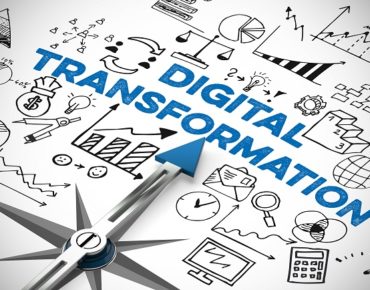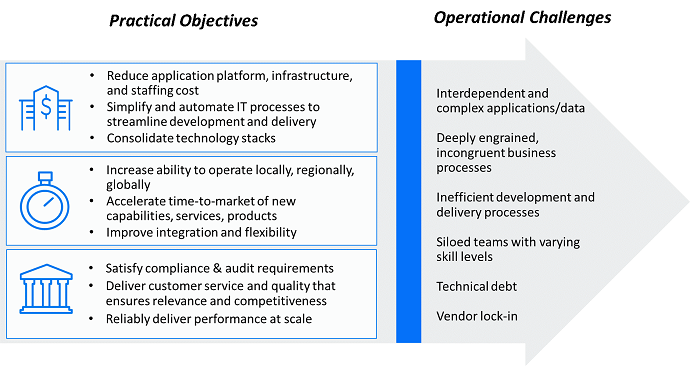Digital Transformation via Modernization: Avoid Rip-and-Replace Disruption

via Shutterstock
Many believe that 2019 will be a watershed year for digital transformation. There are practical objectives and operational challenges that are forcing executives to rethink previous IT strategies. The primary business driver tends to be variable (e.g., greater business agility through DevOps, operational cost savings through new models like hybrid IT, and improved access, security and governance) but the fundamental reality is constant. Each organization needs to change in order to stay relevant, and how one approaches this transformation – and how well they counter the myopia that typically accompanies such projects – generally means the difference between ongoing frustration and lasting success.
For most organizations, particularly those with core business processes and technology that have been in place for many years, the prudent path forward is to digitally transform through modernization. These core systems generally touch business-critical data, which is likely why senior IT executives say 85 percent of these applications are expected to be classified as strategic over the long run1. Moreover, these systems are often the first to be negatively impacted by new initiatives, given the IP and supporting processes that are often built up around them. This is one key reason why less than a third IT project implementations are successful2. With the stakes so high, protecting current processes, leveraging previous investments and utilizing in-place resources naturally represents a lower-risk opportunity.
Compare this to the alternative of starting from scratch, with a largely new set of technologies. Initially there are many perceived benefits to this, including access to cutting-edge technologies and new ways of thinking and solving problems, which is why it tends to be the default methodology. But once theory is confronted by reality, most instead find the net result to be added risk, downtime, complexity, re-education, and resource drain. This is why a prominent industry analyst recently reported: “IDC is seeing a shift from a ‘rip and replace’ approach towards modernization strategies that are aimed at gaining significant business value in the form of agility, new business capabilities, and a reduction in TCO and risk.”3
Critical Aspects of Modernization
Pursuing a modernization strategy can at first seem daunting. There are many variables to consider, buy-in is required at various levels and cross functional teams must be engaged. Often, however, the biggest concern is merely where to start. To simplify, look at the opportunity from three key perspectives to get the complete picture of what needs to be done:
- Application modernization: Upgrade to a modernized, secure user interface and take greater advantage of emerging technologies, such as artificial intelligence.
- Process modernization: Automate processes, take advantage of integration, and enable enterprise DevOps service delivery.
- Infrastructure modernization: Take better advantage of the cloud, containers, analytics, and micro-service deployment, while assuring access security, governance, and controls.
Note that each factor above is independent, but overlapping. This doesn’t mean you have to tackle all three concurrently – in fact, many sound digital transformation strategies concentrate largely on one at a time. A best practice, however, is to take all into consideration as you begin your planning.
Keys to Success
Once the critical elements are clear, make sure your goals are outlined in full. One of the most common reasons why IT projects fail is unclear or evolving objectives. If you are pursuing a mainframe modernization project, for example, achieving better speed and agility with DevOps may be your primary objective. But there is much more you can accomplish at the same time, including lowering costs by leveraging less-expensive storage, increasing throughput and having the ability to surface the data that has been locked away for a long time and making it more broadly accessible to advanced analytics. Make sure you draw the circle big enough on what you’re trying to accomplish at the outset, and then tune your strategy accordingly.
 Then take stock of where you are today and establish where you want to be at a set point in time, and identify and prioritize key IT gaps. This will provide a meaningful structure to build from, and will help you start to crystalize a framework. Equally important, make sure your plan takes your current IT realities into account. This is often described as a modernization maturity model, and it is critical to ensure you balance ambition and risk mitigation.
Then take stock of where you are today and establish where you want to be at a set point in time, and identify and prioritize key IT gaps. This will provide a meaningful structure to build from, and will help you start to crystalize a framework. Equally important, make sure your plan takes your current IT realities into account. This is often described as a modernization maturity model, and it is critical to ensure you balance ambition and risk mitigation.
Finally, no effort to evolve will be successful without taking the time to build a team that can think creatively and adapt to change. In a recent survey, this was supported by 38 percent of CIOs, who said their digital strategies would fail without an innovative and experimental culture4. Make sure you don’t forget the softer components of change management.
Ultimately, organizations need to think twice before adopting a rip-and-replace approach to digital transformation. In the vast majority of cases, organizations have invested a good deal in current technology and the processes that support them. While it can at first seem appealing to start from scratch, often this approach will break down processes, compromise security measures, and put revenue at risk. Instead, look to modernize core business systems. By moving forward in a fiscally responsible and methodical manner, you will be able to bridge the old and new, future-proof investments in core systems, drive new value, and put your organization in a position for long-term prosperity.
Citations
(1) The Future of COBOL Applications 2017 Survey Highlights, Micro Focus, 2017
(2) Standish Group 2015 Chaos Report
(3) IDC, Modernization: A Flexible Approach to Digital Transformation, July 2018
(4) Harvey Nash / KPMG CIO Survey 2018, 5 June 2018
Joe Garber is the global head of strategy and solutions at Micro Focus.










